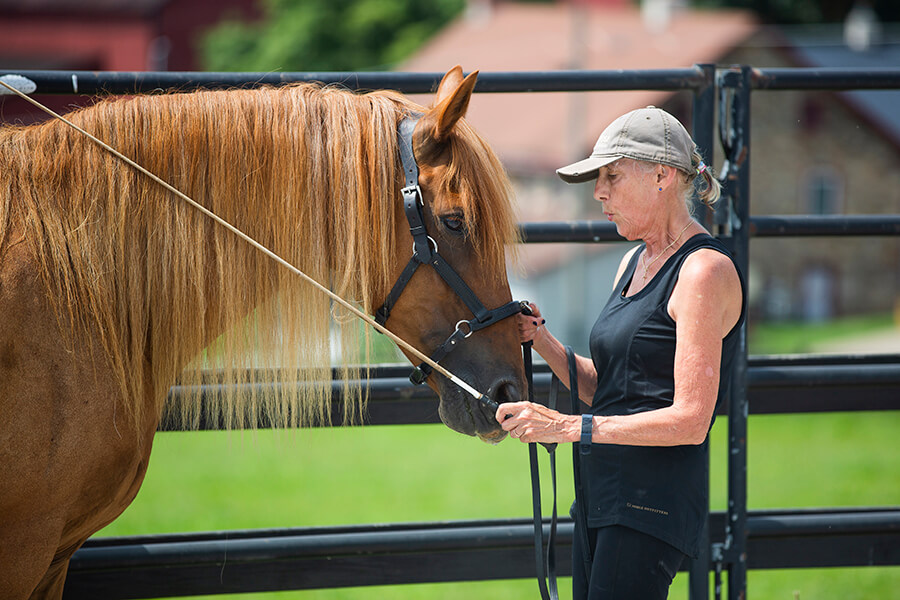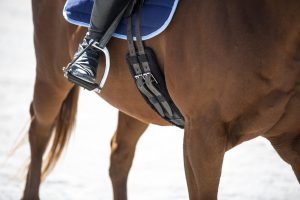Whenever we learn a new technique or exercise, learning it is just the beginning.
Making it part of our routine practice is the key to finding the benefit in any new learning.
We will soon be hosting another In Hand workshop with Patrick King.
The In Hand exercises Patrick begins with are very simple, and can help any horse at any training level, (even your lesson horse) but when to practice them is important.
In the video below I will share 3 times to use In Hand with your horse, and give a quick example of each with my own horses.
(This first one is great for those times you don’t have much time, but still want to do something beneficial for your horse. )
See you in the comments!
Callie














20 Responses
Hi Callie – Thanks for a great video! I notice you use a halter with a ring on top of the nose band. Can you talk about how it works differently from a more traditional halter, and why you use it for Henry?
Thanks!
Hi Sharon, that is the cavesson that Patrick actually sells! It is a great tool for being able to ask for the movements from directly in front of the horse by the nose.
-Julia, CRK Training Community Manager
Callie,
i am excited to start IN HAND work with Mocha!
where can i buy the bamboo pole that you and Patrick are using?
do you have a source?
thanks
and cheers from Colorado?
Marcia
Try a garden supply or hardware store! 🙂
Hi Marcia, hope you are doing well! The bamboo Callie is using actually grows down the street from the farm so I’m sorry but I don’t have a great resource for bamboo!
-Julia, CRK Training Community Manager
I haven’t started the course yet, so maybe this is addressed, but one thing that comes to mind while I was watching you do the in hand work was that I see you’re walking backwards a lot. I remember learning in groundwork training that you shouldn’t back up around a horse because they are then learning they can claim your space. Is that not an issue with in-hand work?
Walking backwards helps to create a DRAW with your energy, inviting the horse to come toward you. As long as you are doing the asking, the horse should be allowed to come to you. Unfortunately many people are inadvertently ‘drawing’ their horse toward them with their body language, and then punish the horse for being ‘pushy’. Awareness of your own self in relation to the horse is key. 🙂
Walking backwards is a really useful technique and enables clear effective communication as you are well positioned to observe the movements and postural changes in your horse. It helps us and the horse with focus and you’re in an effective position to steady without dragging on the horse. It’s up to us to clearly teach the horse when to move and when to stand, as demonstrated in the video. I really don’t think they are waiting to claim our space though your horse might want to be near or think it should move whenever you move so trial such behaviour. If we have clear signals for stand and move then there is no issue. We do lots of walking backwards as it’s so useful for teaching, shaping and tweaking the horses responses. All the best with it.
Hi Jen, this program is really about correct movement from the horse. Walking backwards has nothing to do with the horse claiming your space, it is just the movement we have to make to get the horse to do the exercise correctly 🙂
-Julia, CRK Training Community Manager
I like to use In Hand work to develop my horse’s top line, as he has high withers.
We longe him asking him to go down long and low, to stretch his dorsal muscles,
and neck. Also I have him do shoulder in, and leg yield to explain to him from
the ground what we want to do in the saddle.
It’s excellent work with a horse! Thanks for your input!
Robyn
Great work Robyn, teaching the horse correct movement is so important!
-Julia, CRK Training Community Manager
Callie, thank you so much for this. I am in a very difficult situation as carer to my terminally ill husband. I have a huge young Irish Draught gelding and at the moment it just doesn’t feel right to ride him. I am very tired and therefore don’t think my reactions are good enough for it to be safe – and that feeling of not being a risk taker as my husband depends on me is also top of my head. I had been doing groundwork with him every day until a month ago when my husband had emergency surgery. It was a very difficult time and knocked me for six. Since then all I have done with my boy is feed him and occasionally groom him.
Just today I thought that I must get going with the groundwork again, and there it was, your email and video (accidentally in my spam folder). It was so good to see you doing simple but very useful exercises , and has really helped me to feel motivated again.
Thanks so much for all you do – I really love your videos. I signed up for “unlock your horse’s potential” but haven’t had time to do it all yet – but I will.
I am reminded of a song I heard long ago. “who takes care of the Care Taker” I am so sorry for your husband and you in this time. Perhaps your horse can take care of you. In my worst of times I went to my horses. Stood with them, sat with them in the paddock, cried . they responded.
Hi Annabel, first I want to say how sorry I am to hear about your terminally ill husband. I’m glad you were able to get out and spend some time on the ground with your horses, I’m sure it was therapeutic for both of you.
-Julia, CRK Training Community Manager
I like to use in hand work to guage where my horse is at that day; how much tension she is holding.
That is a great way to check in and see where your horse is at before a ride 🙂
-Julia, CRK Training Community Manager
I”m interested in the in-hand course but would prefer to pay with pay-pal, not wirh card. Is that possible?
Best regards
Suusanne
Hi Susanne, yes! You can pay with Paypal there is the option to pay via Paypal on the checkout page 🙂
-Julia, CRK Training Community Manager
Thank you
You’re so welcome Janette, I’m glad you enjoyed this video 🙂
-Julia, CRK Training Community Manager